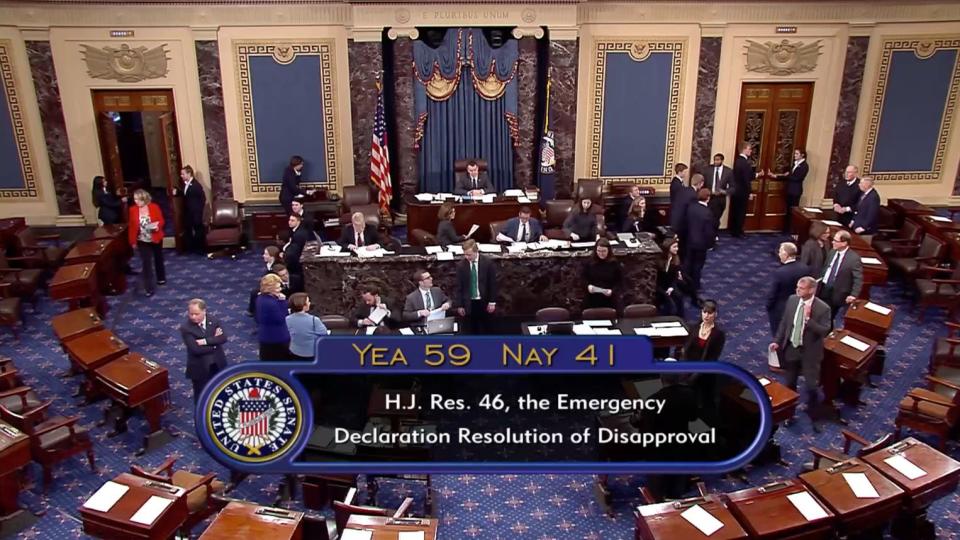Senate votes to block Trump's 'emergency' at border; veto looms
The Senate voted Thursday to block President Trump’s declaration of a national emergency intended to allow funding of a border wall, with a dozen GOP senators going against the White House. Trump said he would veto the measure, which passed the House by a large margin last month.
The final margin was 59-41. Republican senators voting for the resolution and against Trump were Susan Collins of Maine, Lisa Murkowski of Alaska, Roy Blunt of Missouri, Lamar Alexander of Tennessee, Pat Toomey of Pennsylvania, Rand Paul of Kentucky, Rob Portman of Ohio, Marco Rubio of Florida, Jerry Moran of Kansas, Roger Wicker of Mississippi, and Mitt Romney and Mike Lee of Utah.
Shortly after the vote went final, Trump tweeted a single world: “VETO!” He later added, “I look forward to VETOING the just passed Democrat inspired Resolution which would OPEN BORDERS while increasing Crime, Drugs, and Trafficking in our Country. I thank all of the Strong Republicans who voted to support Border Security and our desperately needed WALL!”
VETO!
— Donald J. Trump (@realDonaldTrump) March 14, 2019
He had spent Thursday morning on Twitter attempting to pressure Republicans to back him on the issue.
“A big National Emergency vote today by The United States Senate on Border Security & the Wall (which is already under major construction),” said Trump. “I am prepared to veto, if necessary. The Southern Border is a National Security and Humanitarian Nightmare, but it can be easily fixed!”
“The Democrats are ‘Border Deniers.’ They refuse to see or acknowledge the Death, Crime, Drugs and Human Trafficking at our Southern Border!” he wrote later, adding, “A vote for today’s resolution by Republican Senators is a vote for Nancy Pelosi, Crime, and the Open Border Democrats!”

The Senate vote was outside of Majority Leader Mitch McConnell’s control because it was triggered by the passage of the resolution in the House, where 13 Republicans joined Democrats in a 245 to 182 tally. Neither margin would be large enough to override a presidential veto, but both chambers voting to defy Trump for the first time in his presidency is a major setback at a time when numerous House committees are launching investigations of his campaign, administration and personal business.
The wall was a signature campaign issue for Trump, but he was never able to deliver on his promise to make Mexico pay for it, and the issue languished during his first two years in office. The emergency declaration came after Trump failed to win an appropriation for a border wall in a continuing resolution to fund the government last fall. The resulting deadlock shut the government for five weeks, during which time workers were furloughed or forced to work without pay.
In declaring an emergency on Feb. 15, Trump cited drug smuggling across the border from Mexico (misleading), the drop in crime in El Paso, Texas, after a partial border barricade was built there (not true) and reports of women kidnapped, bound with tape and trafficked into the United States across unguarded sections of the border (no evidence exists of this). Hours later he flew to his Mar-a-Lago resort in Florida for a weekend of golf.
The wall is also facing legal challenges that could be aided by Trump’s own admission that “I could do the wall over a longer period of time. I didn’t need to do this.”
Legislation proposed by Sen. Mike Lee, R-Utah, would have restricted future emergency declarations from presidents while allowing Trump's, but he couldn’t reach a compromise agreement with the White House, and the plan fizzled.
“We tried to cut a deal," Lee said. “The president didn’t appear interested."
Read more from Yahoo News:
Women divided by race over key issues, but with areas of overlap
Maverick Republican William Weld looks to run against Trump's 'malignant narcissism'
The Army's killer drones: How a secretive special ops unit decimated ISIS
The Soviets wanted to infiltrate the Reagan camp. So, the CIA recruited a businessman to bait them.
PHOTOS: In Gaza, women walk thin line between hope and despair


